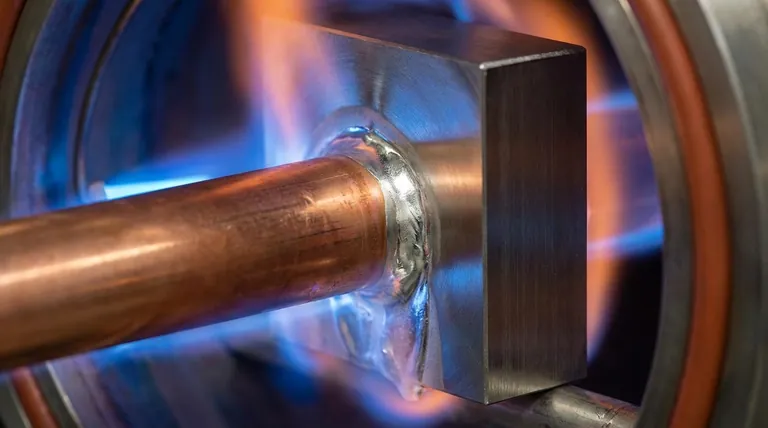はい、異なる2種類の金属をろう付けすることは絶対に可能です。実際、異種材料の接合は、ろう付けプロセスの主要な強みの一つです。この方法により、鋼、銅、ニッケル、アルミニウム、さらにはセラミックスを含む非常に幅広い金属を、接合する2つの母材よりも低い温度で溶けるろう材を使用して接合できます。
中心となる原則は単純です。ほとんどすべての2種類の金属をろう付けできますが、接合の成功は、ろう材が両方の表面を「濡らし」て結合する能力に完全に依存しており、このプロセスには綿密な洗浄と表面酸化物の制御が必要です。
基本原則:「濡れ性」
ろう付けは毛細管現象を利用して機能します。溶融したろう材が2つの母材間の狭い隙間に引き込まれるのです。これが発生するためには、ろう材が表面を「濡らす」ことができなければなりません。
濡れ性とは?
濡れ性とは、水がきれいなガラス板の上で広がる様子と、ワックスを塗った車の表面で水滴になる様子を想像してください。強力なろう付け接合のためには、溶融したろう材が両方の母材表面に滑らかに広がり、完全に接着する必要があります。
表面酸化物の役割
ほとんどすべての金属は、空気にさらされると目に見えない酸化物層を形成します。この酸化物層は障壁として機能し、ろう材が母材に直接接触するのを妨げ、濡れ性を阻害します。
酸化物障壁の克服
ろう付けを成功させるためには、この酸化物層を除去し、加熱プロセス中に再形成されるのを防ぐ必要があります。これは主に2つの方法で達成されます。
- フラックス:加熱前に接合部に塗布される化学化合物。フラックスは溶けて酸化物を溶解し、接合部を大気から保護します。
- 制御雰囲気:特定のガス(水素など)で満たされた炉内、または真空下でろう付けが行われます。この雰囲気は酸化物を化学的に除去するか、そもそも酸化物の形成を防ぎます。

一般的な異種金属の組み合わせ
ろう付けは非常に汎用性がありますが、一部の組み合わせは他の組み合わせよりも簡単です。
鋼、銅、ニッケル合金
これらの材料は、高い成功率で互いにろう付けされます。それらの酸化物は比較的管理しやすく、多くの標準的なろう材(しばしば銀または銅ベースの合金)がそれらと互換性があります。
アルミニウムの課題
アルミニウムはチタン、ニッケル、ベリリウムなどの他の金属にろう付けできます。しかし、その頑固な酸化物層と低い融点のため、特殊なフラックスと正確な温度制御が必要です。
特に、アルミニウムは標準的な技術では銅や真鍮に直接ろう付けすることはできません。これらの組み合わせには、一方の金属をニッケルのようなより互換性のある材料で事前にめっきするなどの特別な対策が必要です。
先進材料:セラミックスと耐火金属
ろう付けの原則は非金属にも及びます。セラミックスは金属にろう付けできますが、ろう合金が両方の表面を濡らすことができる場合に限ります。タングステンなどの耐火金属は、汚染を防ぐために特殊な真空ろう付け技術を使用して、チタンなどの反応性金属に接合されることがよくあります。
重要な考慮事項の理解
異なる2種類の金属を接合すると、信頼性の高い接合を得るために管理しなければならない複雑さが生じます。
ろう材の互換性
ろう材は2つの材料間の橋渡し役です。その融点は、プロセス中に母材が溶けないように、両方の母材よりも低くなければなりません。また、強力な冶金学的結合を形成するために、両方と化学的に互換性がある必要があります。
熱膨張の管理
異なる材料は、加熱および冷却時に異なる速度で膨張および収縮します。この差(熱膨張係数)が大きい場合、冷却時に接合部に immense な応力が生じ、亀裂や破損の原因となる可能性があります。これは、プロセス設計と加熱/冷却速度によって管理する必要があります。
ガルバニック腐食の回避
2つの異なる金属が電解質(湿気など)の存在下で接触すると、ガルバニック電池を形成し、一方の金属が急速に腐食する可能性があります。ろう材の選択はこの効果に影響を与える可能性があるため、特定の環境で長期使用される部品にとっては重要な考慮事項です。
目標に合った適切な選択
あなたのアプローチは、接合する必要がある材料と、要求される性能に完全に依存します。
- 主な焦点が一般的な製造(例:鋼から銅へ)の場合:標準的な銀ベースのろう材と化学フラックスで、強力な接合には十分なことがよくあります。
- 主な焦点が反応性金属の接合(例:アルミニウムからチタンへ)の場合:アルミニウム用に設計された特殊なフラックス、または制御雰囲気炉と、互換性のあるろう合金が必要になります。
- 主な焦点が高性能アプリケーション(例:耐火金属)の場合:これらの要求の厳しい接合には、純度と接合の完全性を確保するために、ほとんどの場合、特殊な真空炉ろう付けが必要です。
これらの中心となる原則を理解することで、ろう付けを使用して、非常に幅広い異なる材料間に強力で信頼性の高い接合を自信を持って作成できます。
要約表:
| 主な考慮事項 | 異種金属にとってそれが重要である理由 |
|---|---|
| ろう材の濡れ性 | 強力な接合のためには、ろう材が両方の金属表面に流れ、結合する必要があります。 |
| 熱膨張 | 異なる膨張率が応力を引き起こす可能性があるため、加熱/冷却を制御する必要があります。 |
| ガルバニック腐食 | 接触している異種金属は腐食する可能性があり、ろう材の選択がこのリスクを軽減できます。 |
| 酸化物除去 | 表面酸化物はフラックスまたは制御雰囲気(例:真空)を使用して除去する必要があります。 |
異種金属間に強力で信頼性の高い接合を作成する必要がありますか?ろう付け雰囲気と温度を制御するには、適切な装置が不可欠です。KINTEKは、ろう付け炉を含む実験室用機器と消耗品を専門としており、完璧な結果を達成するお手伝いをします。お客様の特定の材料と用途に最適なソリューションを選択するために、当社の専門家にご相談ください。今すぐお問い合わせください!
ビジュアルガイド




















